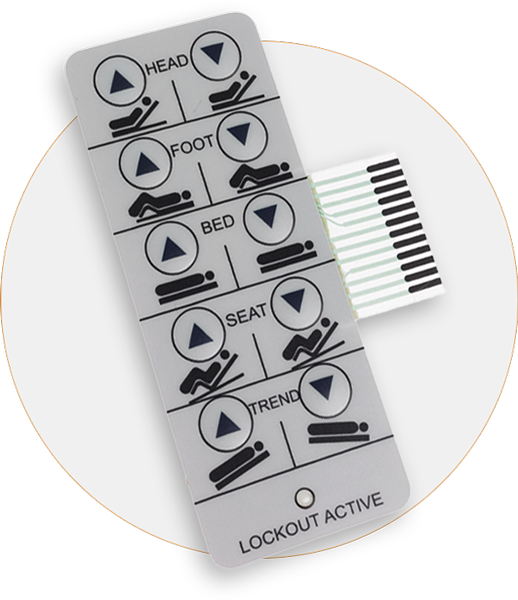All Concerning Membrane Layer Switch: Understanding Its Design and Functionality
When you consider the control user interfaces in modern-day tools, membrane layer buttons typically come to mind. These elements are greater than just switches; they blend layout and performance perfectly. Recognizing just how they work and what makes them reliable can alter your perspective on day-to-day electronic devices. Yet, there are nuances to their design and performance that you might not be conscious of. Let's discover what sets membrane layer switches over besides various other control systems.
What Are Membrane Buttons?

Membrane layer switches can also be customized relating to shape, dimension, and graphics, permitting makers to develop special interfaces customized to specific products. Generally, membrane layer switches play a considerable role in enhancing individual experience across a wide selection of applications.
How Membrane Changes Job
When you press a secret on a membrane button, it turns on a straightforward yet efficient system. The leading layer, usually constructed from versatile material, lowers onto a conductive layer under it. This action bridges the space between conductive traces, completing an electrical circuit. As soon as the circuit closes, it sends out a signal to the gadget's controller, which translates your input.
You'll observe that the responsive responses differs based upon the switch style, offering either a soft click or a more noticable reaction. As soon as you launch the secret, the membrane go back to its initial position, resuming the circuit and quiting the signal. This procedure takes place practically instantly, making certain a responsive individual experience.
Membrane layer buttons are preferred due to their longevity and resistance to dirt and wetness, making them ideal for various applications, from home appliances to clinical tools. Understanding this operation assists you appreciate their extensive usage.
Key Components of Membrane Switches
Understanding the crucial parts of membrane layer buttons is fundamental for grasping their performance and layout. At the core, you'll discover the graphic overlay, which supplies the visual interface for individuals. Underneath that, there's a spacer layer that divides the circuit layers, making certain that they do not make call up until pushed. The circuit layer is where the magic occurs; it is composed of conductive traces that complete the circuit when you press the switch. One more essential element is the adhesive backing, enabling the switch to stick to surface areas firmly. The protective layer shields versus environmental elements and use, extending the button's life-span. Each element plays a significant role in ensuring reputable performance and user communication. By recognizing these elements, you'll acquire understanding right into just how membrane layer switches over operate and their importance in numerous applications.
Products Made Use Of in Membrane Layer Switch Layout
The performance and sturdiness of membrane layer changes greatly depend on the materials utilized in their style. You generally experience polyester and polycarbonate as key substrates as a result of their exceptional stamina and flexibility. These materials stand up to scratches and chemicals, making them ideal for requiring environments.
The conductive layers commonly utilize silver or carbon, selected for their reliability and conductivity. membrane switch manufacturer. Silver gives exceptional efficiency, while carbon is an affordable choice. For the overlay, you may consider a matte or glossy surface, relying on your visual needs and customer experience
Adhesives play a necessary duty too; they bond layers safely and ensure long life. Ensure to choose adhesives that hold up against environmental elements like temperature and humidity. Lastly, do not forget the relevance of a great printing strategy for graphics, as it boosts both functionality and visual appeal. Picking the appropriate products will assure your membrane button stands the examination of time.
Layout Considerations for Membrane Layer Switches
While developing membrane switches, it's vital to take right into account various variables that affect their performance and user experience. Beginning by focusing on the format and button dimension; make specific they're intuitive and simple to navigate.
Confirm your design suits environmental variables, like dampness or temperature level variants, which can affect performance. By carefully considering these aspects, you'll produce a membrane switch that boosts usability and complete satisfaction.
Applications of Membrane Buttons
Membrane layer switches are versatile elements found in numerous applications, from commercial equipment to customer electronic devices. You'll see their influence in machines that need durable user interfaces and in gadgets that benefit from smooth styles. Comprehending these applications helps you value the functionality and functionality of membrane layer buttons in everyday technology.
Industrial Tools Usage
When you're seeking to improve the performance of industrial equipment, membrane buttons provide a trusted option that integrates resilience with user-friendly layout. These buttons are ideal for rough atmospheres, offering resistance to dirt, wetness, and chemicals. You'll locate them in control panels for making makers, heating and cooling systems, and clinical gadgets, where accuracy and responsiveness are important. Their reduced profile indicates they fit flawlessly into different equipment, saving beneficial area while keeping simplicity of usage. With customizable graphics and backlighting options, you can develop an user-friendly user interface for operators, improving efficiency and safety. And also, their long life-span decreases upkeep expenses, making them a next smart investment for your commercial applications. Welcome membrane layer buttons to improve your operations and improve general efficiency.
Customer Electronic Devices Assimilation
In the domain name of customer electronics, membrane switches play an important role in boosting customer interaction and tool performance. Membrane layer switches additionally ensure sturdiness and resistance to dirt and moisture, extending the this lifespan of your electronic devices. By picking membrane switches, you improve not simply the capability yet also the style of your tools, making daily communications smooth and delightful.
Advantages and Drawbacks of Membrane Switches
While membrane layer buttons provide a series of advantages, they additionally feature some downsides that you should consider. One significant advantage is their portable design, making them excellent for space-constrained applications. They're also cost-effective, supplying a resilient option with a reduced production price. On top of that, their smooth surface area is easy to clean, enhancing hygiene in settings like medical facilities.

Nonetheless, there are disadvantages. Membrane buttons can have a much shorter lifespan contrasted to mechanical buttons, especially under heavy usage. They can additionally be much less responsive, which may affect user feedback during operation. If damaged, repairing them can be challenging and commonly needs full substitute. Inevitably, their level of sensitivity to severe temperatures and environmental problems might restrict their effectiveness in particular settings. Balancing these advantages and disadvantages will certainly assist you figure out if membrane buttons are the appropriate fit for your job.
Often Asked Inquiries
The Length Of Time Do Membrane Layer Switches Over Usually Last?
Membrane switches over commonly last between 5 to one decade, depending upon use and ecological conditions. You'll intend to review elements like have a peek at this site wear, direct exposure to moisture, and temperature variations to determine their longevity effectively.
Can Membrane Layer Switches Over Be Personalized for Specific Styles?
Yes, you can tailor membrane buttons to fit details styles (membrane switch manufacturer). You'll have the liberty to choose colors, forms, and formats that match your project's requirements, guaranteeing they mix effortlessly with your overall aesthetic
What Is the Price Variety for Membrane Change Production?
The cost variety for membrane layer button manufacturing normally falls between $1 and $10 each, relying on factors like style intricacy, amount, and products. You can obtain quotes from suppliers to find the finest alternative.

Are Membrane Layer Changes Waterproof or Immune?
Membrane layer buttons can be designed to be waterproof or resistant, depending upon products made use of and construction techniques. If you need them for wet atmospheres, ensure you define those needs throughout the layout procedure.
How Do Membrane Layer Switches Compare to Conventional Switches?
Membrane layer buttons are generally thinner and more flexible than conventional switches, offering a smooth style. They're commonly much easier to cleanse and integrate, but may not offer the tactile comments you're used to with mechanical options.
Final thought
